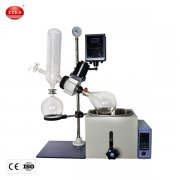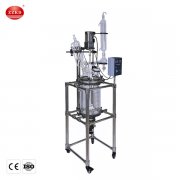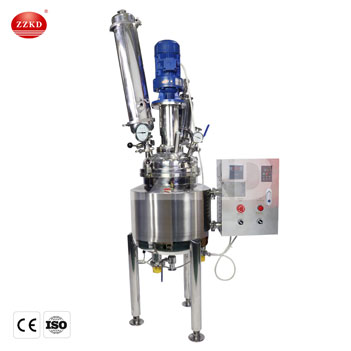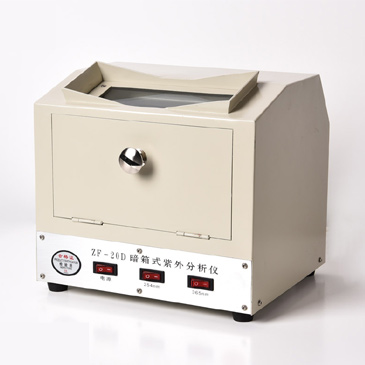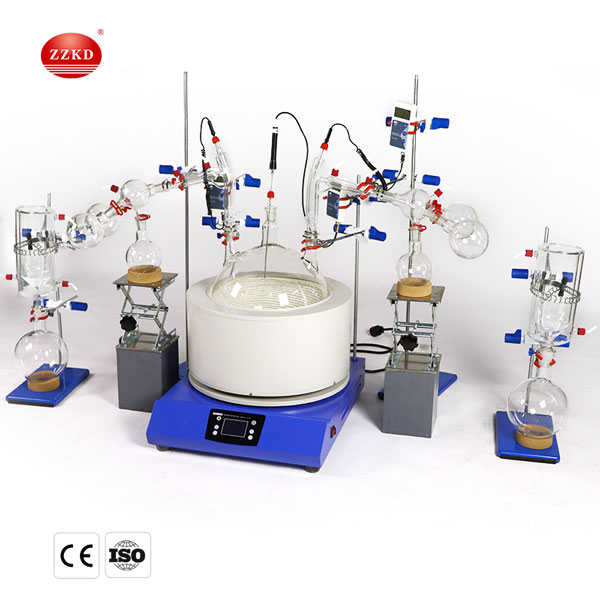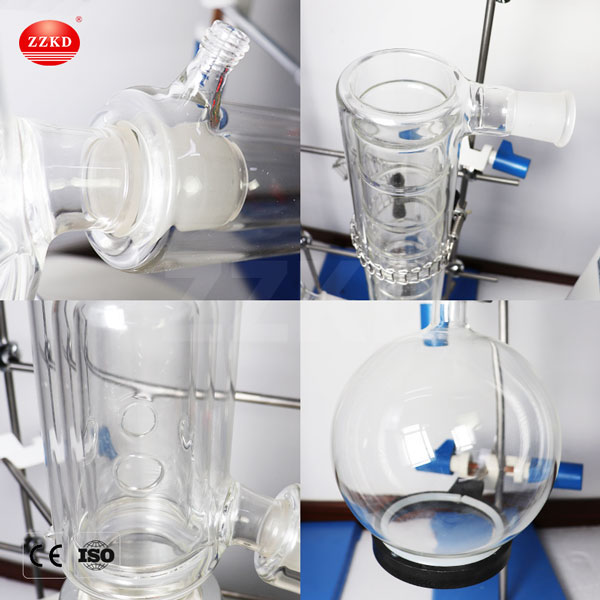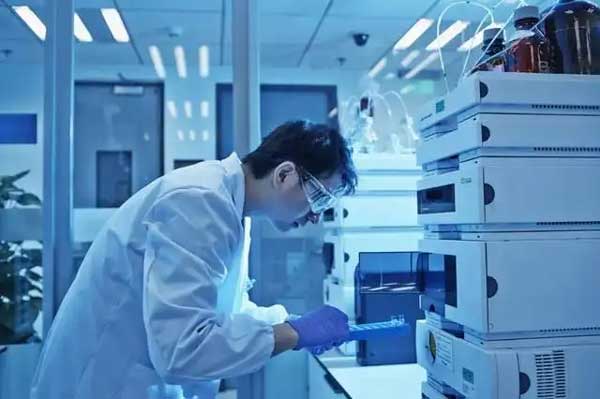Short path distillation lab equipment is a thermal separation technology process working under the pressure of 1~0.001mbar. It has a lower boiling temperature and is very suitable for heat-sensitive and high-boiling materials. Its basic composition: a cylindrical cylinder with a heating jacket, a rotor and a built-in condenser; a film scraper and an anti-splash device are precisely installed on the fixed frame of the rotor. The built-in condenser is located in the center of the evaporator, and the rotor rotates between the cylindrical barrel and the condenser.
A
short path distillation cbd still consists of an externally heated vertical cylinder, a condenser in its center, and a wiper that rotates between the still and the condenser.
Features of Short Path Distillation
1. The distillation temperature is low, and the short-path distillation is operated at a temperature far below the boiling point. As long as there is a temperature difference, the separation purpose can be achieved. This is the essential difference between short-path distillation and conventional distillation.
2. The distillation vacuum degree is high, and the short-path distillation device can obtain a high degree of vacuum inside. Usually, the short-path distillation is operated at a very low pressure, so the material is not easy to be oxidized and damaged.
3. The distillate film is thin and the heat transfer efficiency is high.
4. The heating time of the material is short, and the distance between the heated liquid surface and the condensation surface is less than the mean free path of the light molecules, so the light molecules escaping from the liquid surface reach the condensation surface almost without collision. Therefore, the heating time of the distillation material is short, and the residence time at the distillation temperature is generally between several seconds and tens of seconds for molecular distillation, which reduces the chance of thermal decomposition of the material.
5. The degree of separation is higher, and short-path distillation can separate conventional substances that are difficult to separate.
6. There is no boiling and bubbling phenomenon, short-path distillation is free evaporation on the surface of the liquid layer, carried out under low pressure, and there is no dissolved air in the liquid, so the whole liquid cannot be boiled during the distillation process, and there is no bubbling phenomenon.
7. It is non-toxic, harmless, pollution-free and residue-free, and pure and safe products can be obtained, and the operation process is simple and the equipment is few. Molecular distillation technology can separate substances that are difficult to separate by conventional distillation.
8. The energy consumption of the product is small, because the short-path distillation has less superheat loss in the entire separation, and because of the unique structure of the short-path distillation unit, the internal pressure is extremely low, and the internal resistance is much smaller than that of conventional distillation, so it can greatly save energy.
Advantages of Short Path Distillation
From the above characteristics of short-path distillation technology, it can be seen that it has the following obvious advantages over conventional distillation technology in practical industrial application:
(1) For the separation of high-boiling, heat-sensitive and oxidizable materials, short-path distillation provides the best separation method. Because molecular distillation operates at a temperature far below the boiling point of the material, and the residence time of the material is short;
(2) Short-path distillation can effectively remove substances such as organic solvents, odors, etc. in the liquid, which is a very effective method for the precipitation of the liquid after solvent extraction;
(3) Short-path distillation can selectively distill out the target product, remove other impurities, and can simultaneously separate more than ⒉ kinds of substances through multi-stage separation;
(4) The fractional distillation process of short-path distillation is a physical process, so the separated substances can be well protected from pollution and damage.
Application of Short Path Distillation
Application in petrochemical industry
1. Treatment of residual oil in industry
The residue after vacuum distillation of crude oil accounts for about 25% of the total feed. In practice, solvent extraction is often used to post-process the residue. However, it is difficult to extract all the lubricating oil and paraffin by solvent extraction method, and high molecular substances will be extracted in the process, which will affect the product quality. Using short-path distillation technology to treat residual oil can cut more fractions, and the cutting between fractions is clear, the production capacity is increased, the separated lubricating oil does not contain metal elements, the product quality is good, and it can be directly applied without adding additives.
2. Recovery of lubricating oil
The traditional recovery method of waste lubricating oil is to add polar substances to waste oil, such as surfactants, inorganic salts, etc. as flocculants, and then filter and recycle; or recover by physical methods such as electrical discharge and ultrasonic waves; or by chemical methods Recycling and recycling meet the standard. These methods not only have low yield and high cost, but also cause secondary pollution.
3. Manufacture of precision lubricants
Since siloxane compounds are heat-sensitive substances and their boiling points are above 200e , the separation method of conventional distillation is easy to denature them, and short-path distillation can not only greatly reduce the content of color-forming substances in lubricating oil, but also distill the same amount of silicon. Oxane time reduced by 40%.
4. Purification of product intermediates
Many petrochemical products have problems such as impure smell, a large amount of residual solvent, and unclean removal of polymerized monomers. These "impurities" seriously affect the quality of the products. The traditional method of removing these impurities is often to use higher temperature and higher energy consumption. Large methods, such as vacuum distillation. The use of short-path distillation technology can solve the problem of product disproportionation, condensation or decomposition caused by higher operating temperature in other methods, thus ensuring the quality of the product.
Application in food processing
1. Refinement of aromatic oil
In the traditional distillation process, due to the long heating time and high temperature, it is easy to cause molecular rearrangement, oxidation, hydrolysis and even polymerization, which will destroy the aromatic components. Using short-path distillation under different vacuum degrees, it can purify different components and remove colored impurities and odors, and ensure the quality and grade of aromatic oils.
2. Purification and refinement of vitamins
Due to the large molecular weight of vitamin E, high boiling point, poor thermal sensitivity, and easy oxidation, if ordinary distillation is used, it is difficult for the product quality to enter the international market to compete. Therefore, it is better to use short-path distillation for the concentration and purification of natural vitamin E .
3. Extraction of natural pigments
The traditional extraction methods of carotenoids include saponification extraction, adsorption and transesterification, but the quality of the product is affected by the existence of residual solvent and other problems. The carotenoids extracted by the short-path distillation method do not contain foreign organic solvents, and the color value of the products is very high.
4. Removal of cholesterol
Lanzani et al. applied short-path distillation technology, which not only successfully removed the cholesterol in animal fat, but also made it meet the edible standard, and did not destroy the heat-sensitive substances such as triglycerides in the fat that are beneficial to the human body.
Application in the field of pharmacy
1. Separation and purification of functional fatty acids in nature
Functional fatty acids refer to those derived from human dietary fats, which are needed for human nutrition and health. Some of the corresponding deficiencies and endogenous diseases of the human body have been found, especially advanced social civilization diseases such as cancer, diabetes, etc., a class of fatty acid components have a positive preventive effect on them.
2. Enrichment and purification of fat-soluble trace components in oils
In recent years, the use of short-path distillation technology to enrich and even industrialize the high value-added fat-soluble trace components represented by natural vitamin E has achieved good results.
3. Separation and purification of volatile oil components
The conventional extraction and separation methods of volatile oils often have the disadvantages of low product purity, easy oxidation, easy pyrolysis, and organic solvents, and low overall extraction and separation efficiency. Short path distillation technology has the advantages of short heating time, high degree of separation, no need to add solvent, irreversible, etc. Therefore, using this technology to extract volatile oil components will better solve the shortcomings of conventional methods.

 Products
Products





